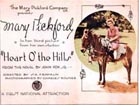
Heart o’ the Hills 1919
Distributed by Milestone Films & Video, PO Box 128, Harrington Park, NJ 07640-0128; 800-603-1104
Produced by the Mary Pickford institute and Timeline Films
Directed by Sidney Franklin
DVD, b& color tinted, 78 min.
Jr. High - Adult
Film Studies, Media Studies, Women's Studies
Date Entered: 07/14/2005
Reviewed by Oksana Dykyj, Head, Visual Media Resources, Concordia University, MontrealAlong with new the Milestone releases Through the Back Door and Suds (also reviewed on this site), Heart o’the Hills is perfectly matched with M’Liss as a double feature of Mary Pickford’s mountain girl films. It is sheer joy to watch Mary Pickford perform. It is also significant that in 1919 Pickford negotiated the establishment of United Artists along with Charlie Chaplin, Douglas Fairbanks and D.W. Griffith; finally arranged her divorce from Owen Moore; and made 3 films for First National.
Sidney Franklin who had previously directed Norma Talmadge in a series of films worked with Pickford on Heart o’ the Hills released on December 1, 1919 as well as The Hoodlum, released a few months earlier. The film was shot in the San Bernadino Mountains substituting for Kentucky. Narratively, the driving force of the film’s theme is revenge, as Mary practices sharpshooting to avenge the murder of her father, but the development of her character, from a spirited young girl full of sweetness to a more culturally aware young woman still sensitive to her inherent decency, provides the film with the necessary layers of dimension to promote it to a higher level of story-telling. The beautifully photographed exteriors convey both Mary’s mountain girl spunk as well as her sweetness through Charles Rosher’s backlit shots highlighting her golden hair. Once again, she plays a 12-year-old girl convincingly. Her close-ups during her trial for murder reveal the face of a child not that of a 27-year-old adult playing a child. I don’t know of any other actress who has ever been able to skillfully accomplish this feat.
A scrawny and gangly 20-year-old John Gilbert appears in the film and even though this is his 32nd credited film, he still has not completely grown into the body of the great silent screen lover he was to become. The print source is outstanding and the sepia tinting is strikingly beautiful. Maria Newman’s musical score occasionally distracts from the film by being deliberately contrapuntal or using rattles or other sound effects that do not add to the narrative but rather play against it. Granted that Soviet film directors declared that soundtracks should create a sharp discord with the visuals in order to cultivate critical thinking in the audience and that Philip Glass has wanted audiences to have an emotional experience based on the disparity between image and music, Maria Newman’s score, although interesting on its own, is just not a good match for a Mary Pickford film. It does not modernize the film or emphasize its assets. Heart o’ the Hills works despite the music as Mary Pickford transcends time through her performance.
The bonus feature on the DVD is M’Liss which was originally released on May 13, 1918. It is 73 minutes long. The exteriors were shot near Boulder Creek in Northern California and again we see beautiful cinematography, this time by Walter Stradling who usually worked with Marshall Neilan and had worked on a number of earlier Neilan/Pickford films before his death in 1918. Wilfred Buckland is the art director and Frances Marion provides the script, one of the 15 or so she wrote for Pickford. In 1917 Mary Pickford’s annual salary was already about $560,000. the equivalent of contemporary stratospheric multi-million dollar a-list celebrity salaries and her control over her films tightened. In this film Mary, once again as a charming, plucky, tough-minded adolescent, fends off a bear and actually picks up a rather long snake that slithers into her one-room schoolhouse. The film also features Monte Blue as a hired murderer. Blue, first as a leading man and then as a character actor, worked steadily from the mid-teens through the 1950s. The b& source print is of good quality and the complementary musical score is by Donald Sosin. The DVD also features numerous stills and an article by Daniel Egan which requires Adobe Acrobat Reader software.
This DVD is highly recommended for libraries developing collections in the history of silent film as well as those supporting programs in Film/Media Studies as well as Women’s Studies.